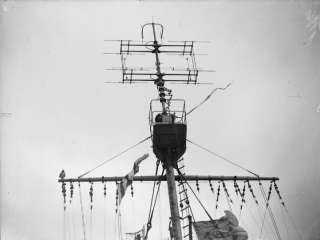Type 281
Description of the radar set, tactical-technical characteristics

Figure 1: Type 281B Aerial on board HMS SWIFTSURE at Scapa Flow
(the vertical polarised pair of antennas on top ist the Type 243 IFF interrogator)

Figure 1: Type 281B Aerial on board HMS SWIFTSURE at Scapa Flow
(the vertical polarised pair of antennas on top ist the Type 243 IFF interrogator)
| Specifications | Type 281 | Type 281B |
|---|---|---|
| frequency: | 39 … 72 MHz
(HF-Band) |
86 … 94 MHz
(VHF-Band) |
| pulse repetition time (PRT): | ||
| pulse repetition frequency (PRF): | 50 Hz | |
| pulsewidth (τ): | 15 or 3 µs | |
| receive time: | ||
| dead time: | ||
| peak power: | 60 … 70 kW | 350 or 1 000 kW |
| average power: | 2 kW | |
| instrumented range: | 100 NM (≙ 185 km) |
120 NM (≙ 222 km) |
| range resolution: | ||
| accuracy: | ||
| beamwidth: | 35° | |
| hits per scan: | ||
| antenna rotation: | ||
| MTBCF: | ||
| MTTR: | ||
Type 281
The Type 281 is an operating in HF-Band British naval early warning radar introduced in 1940. The first version used different antennas for transmitting and receiving. In 1943, a single mast version of type 281 became available, called type 281B. Its transmitter used a pair of type NT 86 high power valves.
